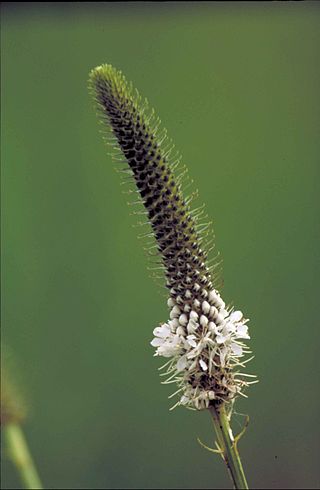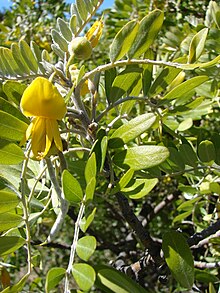
Kōwhai are small woody legume trees within the genus Sophora, in the family Fabaceae, that are native to New Zealand. There are eight species, with Sophora microphylla and S. tetraptera being the most recognised as large trees. Their natural habitat is beside streams and on the edges of forest, in lowland or mountain open areas. Kōwhai trees grow throughout the country and are a common feature in New Zealand gardens. Outside of New Zealand, kōwhai tend to be restricted to mild temperate maritime climates.

Sophora microphylla, commonly known as weeping kōwhai and small-leaved kōwhai, is a species of flowering tree in the family Fabaceae native to New Zealand. It is the most widespread of the eight species of kōwhai. It is also called South Island kōwhai, although this name is misleading as it is widely distributed throughout the main islands of the country.

Dermatophyllum is a genus of three or four species of shrubs and small trees in the subfamily Faboideae of the pea family, Fabaceae. The genus is native to southwestern North America from western Texas to New Mexico and Arizona in the United States, and south through Chihuahua, Coahuila, and Nuevo León in northern Mexico. Members of the genus are commonly known as mescalbean, mescal bean, or frijolito. One of the common names of Dermatophyllum secundiflorum is Texas mountain laurel, although the name mountain laurel also refers to the very dissimilar and unrelated genus Kalmia and the name laurel refers generally to plants in the unrelated order Laurales.

Coprosma is a genus of flowering plants in the family Rubiaceae. It is found in New Zealand, Hawaiian Islands, Borneo, Java, New Guinea, islands of the Pacific Ocean to Australia and the Juan Fernández Islands.

Clianthus, commonly known as kakabeak, is a genus of flowering plants in the legume family Fabaceae, comprising two species of shrubs endemic to the North Island of New Zealand. They have striking clusters of red flowers which resemble the beak of the kaka, a New Zealand parrot. The plants are also known as parrot's beak, parrot's bill and lobster claw – all references to the distinctive flowers. There is also a variety with white to creamy coloured flowers called: "Albus," and a variety with rosy pink flowers called: "Roseus."

Anthyllis is a genus of flowering plants in the family Fabaceae. This genus contains both herbaceous and shrubby species and is distributed in Europe, the Middle East and North Africa. The most widespread and familiar species is A. vulneraria, a familiar grassland flower which has also been introduced to New Zealand.

Dalea is a genus of flowering plants in the legume family, Fabaceae. Members of the genus are commonly known as prairie clover or indigo bush. Its name honors English apothecary Samuel Dale (1659–1739). They are native to the Western hemisphere, where they are distributed from Canada to Argentina. Nearly half of the known species are endemic to Mexico. Two species of Dalea have been considered for rangeland restoration.
Gennady Pavlovich Yakovlev Russian botanist, pharmacognosist, phytochemist. Former director of Saint-Petersburg State Chemical-Pharmaceutical Academy (1992–2004). Expert in Fabaceae taxonomy.

Galegeae is a tribe in the flowering plant family Fabaceae, subfamily Faboideae. The tribe is found mostly in the northern hemisphere, but can also be found in Australia, Africa, and South America. Recent molecular phylogenetic work has determined that tribe Galegeae is paraphyletic, and that its members are scattered throughout the IR-lacking clade.

Sophora cassioides is a legume tree native to Chile.

Clianthus maximus, commonly known as kaka beak, is a woody legume shrub native to New Zealand's North Island. It is one of two species of Clianthus and both have striking clusters of red flowers which resemble the beak of the kaka, a New Zealand parrot.

Uresiphita polygonalis is a moth of the family Crambidae. The species was described by Michael Denis and Ignaz Schiffermüller in 1775. It is found in the Pacific, including Hawaii and New Zealand, Sri Lanka, Europe and northern and southern Africa.

Dermatophyllum gypsophilum is a rare species of flowering plant in the legume family known by the common names Guadalupe Mountain necklacepod, Guadalupe mescalbean, and gypsum necklace. It is native to New Mexico and Texas in the United States, and it is known from one location in Chihuahua in Mexico.

The Paradisus Londonensis is a book dated 1805–1808, printed by D.N. Shury, and published by William Hooker. It consists of coloured illustrations of 117 plants drawn by William Hooker, with explanatory text by Richard Anthony Salisbury.

Sophora chathamica, the coastal kōwhai, sometimes known as Chatham Island kōwhai, is one of 8 species of native sophora or kōwhai in New Zealand and grows naturally in the north-west of the North Island in New Zealand, as far south as the Tongaporutu River in north Taranaki, and as far north as Te Paki. It can also be found growing near Wellington and the Chatham Islands, although these later plantings are thought to be a result of Māori plantings in the late 18th century and early 19th century. Prior to 2001, it was included as variant of Sophora microphylla, therefore references to either Sophora microphylla var. chathamica or Sophora microphylla subsp. microphylla var. chathamica are considered references to coastal kowhai.
Montigena is a genus of flowering plant in the legume family Fabaceae. It includes the sole species Montigena novae-zelandiae, known more commonly the scree pea, a dicotyledonous herb endemic to the South Island of New Zealand. The plant is small and woody, arising from thin, branched stems that extend to the surface from a deeply buried root stock. The flowers vary from purple to brown, while fruits appear between January and April.














